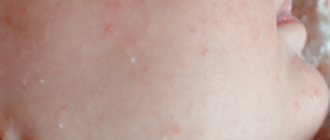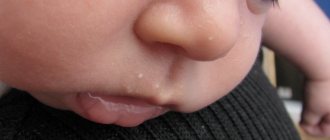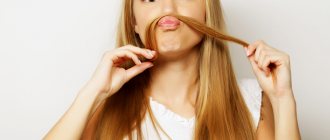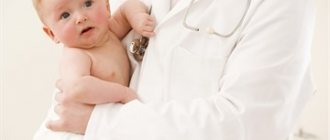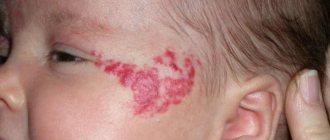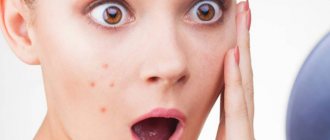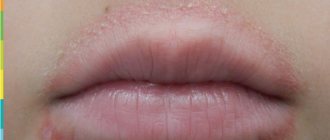Rashes on the body and head in infants occur quite often. Children with perfectly smooth skin are rare. The rash can be caused by various reasons.
It is important for parents to know why pimples appear on the baby’s head and how to treat this condition.
Small pimples broke out on baby
Rashes on the face and body of newborns are not a disaster. In fact, almost every second parent faces this problem. And sometimes a rash is a variant of the norm. In particular, small pimples in a baby can be:
- Milia, or small whiteheads (usually found on the nose and chin).
- Erythema toxicum - yellowish-white pimples with a reddish ring.
- Prickly heat.
- Red pimples and pustules, like teenagers.
- Allergic rashes (most often found on the cheeks).
- Manifestations of dermatitis.
The listed causes of acne are quite harmless; they do not pose a direct threat to the child. But sometimes a rash becomes a symptom of infectious diseases and other serious conditions.
Only an experienced pediatrician can accurately determine the causes of acne.
When to see a doctor
It often happens that the cause of pimples on the head is not so easy to determine.
In this case, there is no need to self-medicate; you need to seek help from a doctor. There is no need to risk your baby's health. You should immediately contact a specialist in the following cases:
- The temperature has risen;
- Purulent rashes are surrounded by a red rim and are swollen;
- The child refuses food, body weight decreases;
- Abnormal bowel movements appear;
- There are signs of intoxication. Only a specialist can accurately determine the cause of skin rashes and prescribe the correct treatment regimen.
Rash on the head of a month old baby
A few weeks, more often 1 month after birth, acne may appear on the baby’s skin. The reason for their occurrence lies in the stabilization and formation of hormonal levels. Such rashes do not require any targeted treatment, but during the period of their appearance, parents need to take especially careful care of the baby’s skin:
- Avoid using fatty oils.
- Bath in a weak solution of potassium permanganate or add infusions of medicinal herbs, such as chamomile or string, to the bath.
- Do not allow the child to overheat.
- Arrange regular air baths.
Sometimes pimples on the cheeks of a child at one month of age, which are combined with redness and roughness of the skin, are the first manifestations of atopic dermatitis. This is a chronic disease that requires timely diagnosis and constant supportive therapy under the supervision of a qualified physician.
Features of treatment
When purulent acne develops in a child, the first step should be to visit a doctor and diagnose the cause. It is necessary to establish why the rashes began to appear.
It is strictly forbidden for children to squeeze out pimples on their own; they can be smeared with special preparations only on the recommendation of a specialist.
To prevent new rashes, you must follow the following rules:
- proper nutrition;
- exclusion from the diet of sweet, flour, fatty foods;
- compliance with hygiene rules;
- timely examination by a dermatologist.
Cosmetic procedures
Cosmetic procedures that may be prescribed to a child include:
- ultrasonic exposure – helps clean pores and normalize microcirculation in skin cells;
- gentle peelings – cleanse pores, eliminate excess dead cells;
- mesotherapy – with the help of medicinal mixtures, inflammation is relieved and the skin is healed.
Medication
If the child is under 9 years old, then self-use of acne remedies is strictly prohibited. They can be harsh on sensitive skin.
Severe acne in a child under 9 years of age is often accompanied by itching, dryness and pain. The above medications will soften inflammation and slow down the production of sebum.
The ionic colloidal solution is gentler, but at the same time destroys bacteria in the skin and helps relieve itching.
If the pimples resemble mosquito bites, provoke pain and do not go away for a long time, then the use of special ointments will be necessary.
At home
In young children, acne can be effectively treated with mild baby soap. You should wash your child with soap once a day, not more often, otherwise the situation will only worsen.
During therapy, it is forbidden to squeeze out the rash. The skin becomes very irritated and the affected area only increases.
As a rule, pimples in children go away on their own. The main thing is to keep your skin clean. If you experience severe discomfort or pain, you should consult your doctor.
Small red pimples on a baby
There are several conditions in which red pimples may appear on a child's skin. Among them are:
- Allergic reaction. Manifestations of individual intolerance are most often recorded on the baby’s cheeks, as well as on the forearms and chest. Allergies are often accompanied by redness and flaking of the skin; they can be caused by food, medications, care products, wardrobe items, etc.
- Prickly heat. This disease develops if the baby’s skin overheats. Pimples are most often found in skin folds; on the head they are found in the back of the head and behind the ears, and can spread to the baby’s neck. The skin around them turns red, and weeping may occur. In the early stages of development, prickly heat can be easily treated - it is only important to stop overheating the baby, bathe him regularly and give him air baths.
- Toxic erythema. This condition can occur in newborns in the first few days of life. It is characterized by the appearance of red pimples-spots on the child’s body and face, similar to allergies. In the central part of the rash, bubbles or tubercles of a yellowish-gray color are observed. This condition is considered borderline and is explained by the baby’s adaptation to extrauterine life. Toxic erythema goes away without treatment in just a week.
- Various infectious diseases. Such conditions are usually accompanied by more serious symptoms, in particular an increase in temperature. The rash is not limited to certain areas of the body.
If a red rash appears on the baby’s skin for no apparent reason, it is better to call a doctor at home as soon as possible.
Probable pathological diseases
The following types of possible diseases are distinguished:
- Staphylococcus aureus causes blistering rashes from 1 to 2 weeks of life. Papules with liquid sometimes reach 1-2 centimeters. When they burst, erosion occurs. The little one becomes restless. The doctor prescribes antibiotics and anti-inflammatory ointments. Lack of treatment leads to pneumonia, otitis, and abscesses.
- Intestinal dysbiosis is characterized by large pimples on the face of a baby. When the disease is eliminated, the ulcers go away on their own.
- Airborne diseases occur in children in the same way as in older children. You don’t have to leave the house to become infected; anyone can bring the infection, including the baby’s mother or father.
Pustules on the body
The formation of pustules on the body and face of a baby can be a rather alarming symptom and a natural condition that does not require targeted treatment. So, such pimples can appear due to:
- Hormonal fluctuations. When a baby has recently been born, his mother’s hormones are still in his blood, and his own endocrine system is just learning to work correctly. The processes of elimination of maternal hormones may be accompanied by the formation of small pustules and acne. Such acne does not bother the baby at all.
- Toxic erythema. We talked about this state a little higher. If it is generalized, then the baby’s body may become covered with many rashes and pustules. At the same time, the baby’s condition worsens, the rash brings discomfort, and the temperature increases.
- Attacks of various bacteria. When pathological pustules appear, the skin around them appears swollen and red. The blisters can grow and burst, resulting in the formation of ulcers and erosions on the baby’s body. A bacterial rash requires targeted treatment under the supervision of a doctor.
Most often, pustules on the body of infants occur due to natural hormonal processes in the body and go away quite quickly. But only a doctor can accurately determine the cause of their appearance.
Preventive actions
It is much easier to prevent a rash on a child’s head than to try to get rid of it later. Therefore, parents should know how to care for and feed the baby correctly.
Pediatricians give the following recommendations:
- maintain optimal humidity and temperature in the room. Protect the baby from overheating;
- dress the child according to weather conditions and the microclimate in the apartment;
- change clothes regularly;
- take a responsible approach to the choice of infant formula. It is worth giving preference to quality products;
- do not use deodorizing agents in the children's room;
- keep the baby's body and head clean. At the same time, you should not use hygiene products (shampoo, gel) too often;
- prevent the child from sweating;
- introduce new foods into the baby’s diet carefully, in minimal quantities, taking into account the body’s reaction;
- ensure that the diet is balanced and rational;
- avoid sudden changes in temperature;
- ventilate the room more often;
- use hats for children made from natural hypoallergenic fabrics.
Following these tips will help you avoid trouble. If your child does develop pimples, you should not self-medicate. An illiterate choice of medications can cause the condition to worsen.
White spots in an infant
Tiny white dots on a baby's skin are a very common occurrence. Small pimples are called milia; they are most often localized on the nose, but can also be found on the forehead or cheeks. The main reason for their appearance is blockage of the sebaceous ducts, which, in turn, is caused by insufficient maturity of the sebaceous glands.
Whiteheads disappear from a child’s skin in just a few weeks, and parents are advised to:
- Care for your baby as usual.
- Do not overheat the baby excessively.
- Do not lubricate milia with any creams, ointments, or especially medications.
- Do not try to squeeze out the white dots, pick them up or remove them with a washcloth, etc.
If you try to get rid of milia mechanically, this will not speed up the process of eliminating them, but will bring discomfort to the baby and also increase the risk of infection.
What parents can do
Therefore, it is very important to seek medical help as soon as possible. As soon as parents suspect the possibility of developing a purulent abscess in their child, they should immediately visit a doctor
After studying all the symptoms, the baby will be prescribed a general blood test to determine the level of leukocytes in the blood - the protective reaction of the body’s immune system to foreign influences. It is also possible to puncture the pus to study it in detail. In special cases, an X-ray examination or MRI may be prescribed. To determine treatment tactics, the location of the abscess is also important - depending on the location of the suppuration, various measures may be needed.
Parents should understand that self-treatment of an abscess at home is only permissible if the inflammation was caught at the very beginning. But at this stage of development of the disease, symptoms are practically not expressed. Usually, a visit to a doctor occurs when the development of the abscess has already gone too far and the child’s health is in danger. Serious suppurations can only be treated with surgery. The capsule with pus must be opened and the tissue cleaned. To prevent inflammation from starting again, the child will need active antibacterial therapy. If the child’s health has suffered greatly, there is a possibility that part of the adjacent tissue of the organ will be removed.
Typically, such manipulations - dressings and taking medications - are performed in a hospital setting. A purulent abscess is too dangerous a disease to risk the possibility of improper therapy or poor sanitary conditions.
How to distinguish acne in newborns from allergies.
When you realize that your baby has acne and this disease will go away on its own, it is worth determining whether it is an allergy?
So, let's find out how to distinguish acne from allergies?
- Place. An allergic rash occurs due to contact with irritating allergens, be it a cream, powder, or other substance. If you put cream on your baby’s back, then if an allergy develops, a rash will appear in this very place. It is worth noting that in most cases, acne appears on the baby’s face or neck, and allergies can spread throughout the body.
- Itching. Allergic effects, unlike acne, are accompanied by unpleasant itching.
- Colic. Loose stools. Temperature.
Parents should not worry about the condition of their baby, since acne disappears on its own after a hormonal surge. There will be no slightest scars or other traces of acne left on the skin. Acne does not cause physical suffering in a newborn.
Allergies in infants are divided into contact or food allergies. Food allergies are characterized by the presence of rough spots on the baby’s cheeks that rise above the entire skin of the child.


